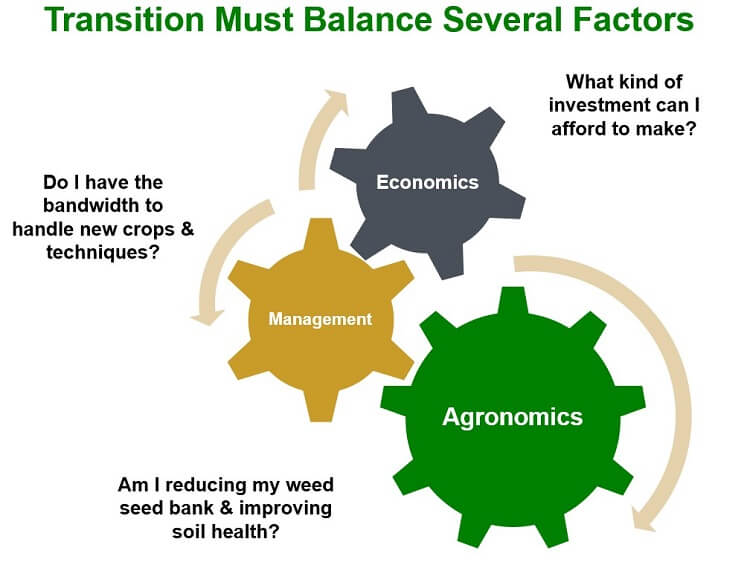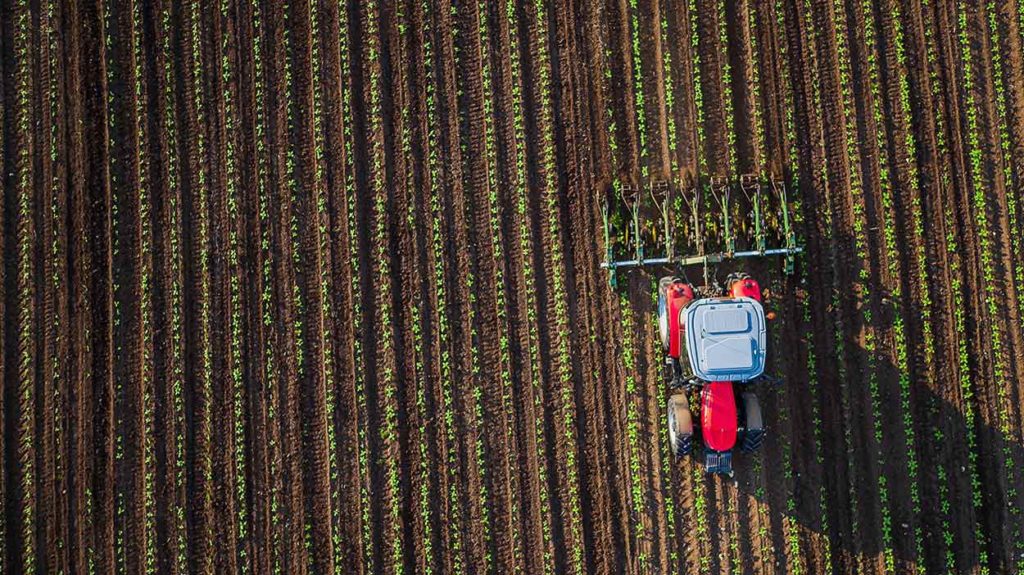- Published On: October 2, 2019
- Author: Steve Sinkula
Becoming an organic producer does not happen overnight. Obtaining organic certification requires a 36-month period where a field has not had any prohibited substance or genetically modified crops on it. These 3 years known as the transition process can either set your organic operation up for success or struggles.
To help ensure success, we recommend growers think of transitioning as a 3-legged stool. While each leg — economics, agronomics, and management — are all key factors, if they’re not in balance with each other, the stool will collapse.

Start with economics
We focus on the economic leg of the stool first because it’s the foundation to long-term success. You need to understand how you’re positioned with your cash-flow and what your bank is willing support.
For example, alfalfa is a great crop to have in that 3-year transition period, but it is an investment. You may lose $150 to $200 on it in the first year and recoup year one losses in the second year to breakeven., but by the third year you’ll have added $100 of nitrogen to the soil and reduced the weed seed bank — a huge benefit to first year certified-organic corn.
While in the long run this will pay dividends in your organic operation, you have to be able to withstand that potential loss in the first year, which not all farmers can afford.
You’ll also have to consider your equipment capacity and whether you can or need to invest in equipment to effectively grow your planned transition and organic farm.
Understanding your risks and your crop insurance levels for corn and soybeans are also important factors for the economics of transitioning. If, for example, you grow wheat during transition, which is another attractive rotation crop, you’ll need to know the risks you may have with delivering to certain markets.
Balance with agronomics and management
Once you understand the economics of transitioning and what you can afford to do, you need to focus on balancing the agronomics and management aspects of the transition.
When balancing these remaining two legs, there are two goals you want to achieve:
- Building agronomic benefits for your first organic year
- Gaining familiarity with organic practices for the crops you will be growing
Building agronomic benefits in your fields includes controlling weeds, correcting soil nutrient imbalances, and doing what you can to prevent any future disasters, such as disease, to your organic crops.
With weeds, the status quo does not exist in organic production — you’re either moving forward or going backwards in controlling weeds and reducing their seedbank. In the beginning of managing organic (and transition) crops, you’re not going to be perfect at it, so you want to pick the right tools and practices that you can manage.
Weed management plays a critical role in selecting your transition crops as some crops (such as alfalfa) allow for better weed control versus others. For example, weed management with soybeans can be extremely challenging in transition or organic systems.
You also need to focus on getting your soil health in balance. This includes getting your soil’s nutrients to the right levels, which in turn can help prevent other agronomic issues. For example, soils low in calcium are typically harder and have more grass weeds because they like hard, compacted soils. By getting the soil in balance with the correct nutrients and rotation, you’re less likely to have poor crops and issues with weeds.
This leads into the second goal: being familiar with the crops you’re growing and understanding the agronomics and management of them. While alfalfa is a great crop agronomically for transitioning, many farmers can’t manage it because they don’t have the equipment and labor. Other crops to consider for transition include wheat, barley, field peas, and corn. In fact, getting a bit of experience with corn during transition may help you for your first organic year.
Both transition goals are critical because corn is likely going to be your most valuable crop and grown during your first organic year. A successful transition program will set the stage for the rest of your organic production. If you can be successful with organic corn, you’ll be profitable — being able to pay off any debts from your transition and be ready to continue moving forward. If you have a poor corn crop in the third year because you let weeds get out of control or you depleted the soil of nitrogen during transition, then you’re setting yourself up for a tough road ahead.
How much can you manage?
One of the main challenges with transitioning is figuring out the management leg. It can be difficult to determine what you can and can’t manage getting into organics because things can get out of control a lot quicker than they do in conventional farming.
If you’re thinking about transitioning to organic and you’re trying to figure out how much you can manage, while balancing the economics and agronomics of organic production, AgriSecure can help. We’ll work with you to determine how many acres you can handle, what rotation to have in place, and walk you through the process of becoming organically certified. Contact us to set yourself up for a successful transition today.
By Bryce Irlbeck, AgriSecure Founder and Owner of B&B Irlbeck Farms
Related Articles
-
Imports Have an Impact on Organic Crop Prices: Here’s Why
Organic soybean prices are skyrocketing. The Jacobsen reported that prices were up to $32 per bushel in the Midwest in May 2021. What’s behind this impact on organic crop prices? And why aren’t organic corn premiums keeping up? In short: it’s all about supply and demand, especially imports, says David Becker. David is an analyst […]
-
New Options Offer Farm Loans for Organic Transition
If securing farm loans for organic transition feels daunting, we have some good news. It’s not as hard as it used to be. In fact, there’s a number of new options that could provide a solution for you and your operation. Traditional lenders, farmland investors, non-profits, and even big food companies are starting to create […]
-
Organic Farming Loans Support Growers during Transition
Ask a farmer what’s keeping them from transitioning to organic row crops, and you may be surprised to hear a common answer. Finances. It’s often a struggle to find organic farming loans tailored to their needs. Yes, organics offer excellent premiums and can bring long-term profitability. But first you have to get through the 36-month […]
-
Organic Breakevens: What to Know and How to Calculate
If you’re thinking about organics, you’ve probably debated whether it’s going to pay off — literally. Yes, the price premiums are good, but you’ve heard your yields will take a hit. How can you predict profitability? The answer: calculating your organic breakevens. What are an organic breakevens? Simply put, it’s a way to calculate what […]
-
Know Your Numbers to Push Crop Profitability
Yield is often the top priority in farming. The truth, though, is that the highest yields will not necessarily result in the highest ROI. And this is especially the case for organic production. We know good execution results in the best yields, but the best way to maximize your crop profitability is to know your […]
-
6 Ways to Protect Organic Profits in Uncertain Times
Economic uncertainty hits all sectors of the agriculture industry, including organics. The good news? It’s possible to safeguard your organic profits. For a start, it’s even more important for organic farmers to focus on executing their operations really well. The better the execution, the better you can weather the market conditions and remain profitable. Here […]
-
5 Steps for Financing the Transition to Organics
Profits. They’re one of the primary reasons farmers decide to move into organic production. Financing the transition to organics, though, can be one of your biggest hurdles. That’s why the support of a banker or ag lender can be a lifeline for farmers looking to get into organics. The right backing helps you build an […]
-
4 Keys to a Strong Organic Fertilizer Strategy
Questions about an organic fertilizer strategy are common in organic farming. How do I provide enough nutrients? In particular, nitrogen. How do I manage my crop and soil without using synthetic fertilizers? Fertilizer can come from a variety of organic sources, including animal waste, decomposing plants, and nitrogen-fixing crops like soybeans and clover. So it’s […]
-
Consider Organic Farming? Yes.
With so much economic uncertainty caused by the COVID-19 pandemic, you may be wondering: Is now the right time to transition into organic crop production? Is this the right time to increase the number of organic acres you’re already farming? My answer, yes. Current market conditions, falling commodity prices for conventional crops and somewhat lower […]
-
80 Million Millennials Can’t Be Wrong: Farmer Panel
80 million millennials are a part of the driving force behind the rapid growth of organic food demand. So why aren’t more farmers transitioning into a system that sees premiums of 2x over conventional and profitable margins? In a panel that took place at FBN’s Farmer2Farmer V event, AgriSecure co-founder and organic farmer Bryce Irlbeck […]
Get in the know
Our newsletter, it’s a quick read. You’ll get industry news plus all the latest organic insights. Who doesn’t want that?










